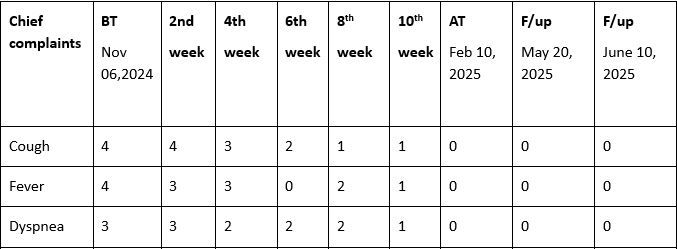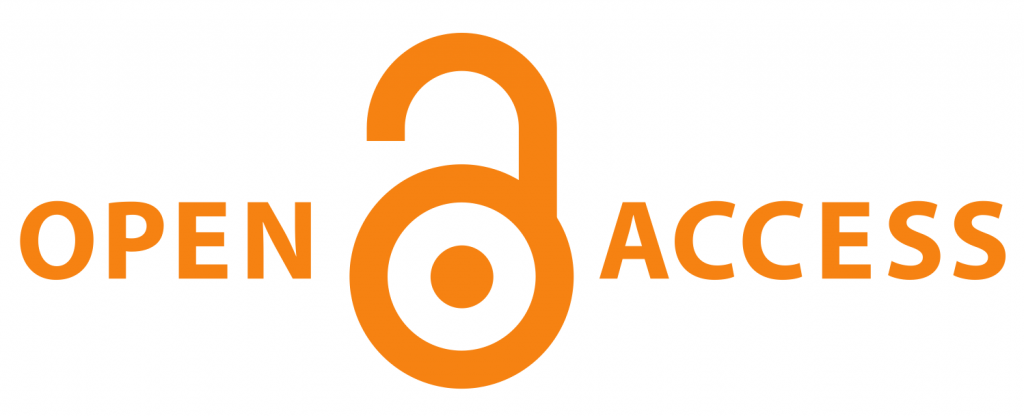Ayurvedic approach in the management of Pulmonary Tuberculosis w.s.r. to Rajayakshma - A Case Report
DOI:
https://doi.org/10.21760/jaims.10.9.50Keywords:
Ayurveda, pulmonary tuberculosis, tuberculosis, RajayakshmaAbstract
Pulmonary tuberculosis (PTB) is an infectious disease caused by Mycobacterium tuberculosis, primarily affecting the lungs. It is transmitted through airborne droplets generated when an infected person coughs, sneezes, or speaks. A 55-year-old female patient with chief complaints cough with yellowish expectoration, fever with chills, weight loss, generalized weakness, and breathlessness on exertion along with chest pain for 3 months visited the TB chest OPD of Kayachiktsa. She was diagnosed with Pulmonary tuberculosis by allopath hospital. After the initiation of anti-Koch’s treatment (AKT) (Rifampicin300 + Isoniazid150 + Pyrazinamide800 + Ethambutol550) for 20 days, she was suffering from burning in abdomen, vomiting after every meal, loss of appetite, joint pain and severe weakness. The patient was not taking medicine properly and wanted Ayurveda as an alternate or adjuvant management for her sufferings. Ayurvedic treatment along with the ongoing medications that comprised Vishama Jwaraghana Vati in the dosage of 1g thrice a day, Sitopaladi Churna, 3g thrice a day with honey for 1 month, and after that Drakshavaleha in the dose of 10 grams twice a day with lukewarm milk after breakfast and dinner for the duration of next 5 months along with Pathya-Apathya was provided. The patient was monitored for clinical outcomes, sputum conversion, complete blood count, reduction in ESR, nutritional status, symptom improvement, and quality of life by WHO-BREF scale. Follow-up was taken for eight months. Significant improvements were observed after three months in terms of the clinical outcomes, including sputum conversion (BT:2+, AT: Negative, 6 month sputum culture-negative), complete blood count (BT: Hb-10.5, RBC-4.16, WBC-14500, Platelet count-469000, AT: Hb-11.9, RBC-4.36, WBC-11730, Platelet count-329000), reduction in ESR (BT:96, AT:27), improvement in nutritional status, early symptom improvement, and quality of life by WHO-BREF scale. This suggests that integrating Ayurvedic approaches with standard PTB therapy may improve treatment outcomes, enhance adherence to medication, support nutritional recovery, and improve patients’ overall quality of life.
Downloads
References
Brennan PJ, Nikaido H. The envelope of mycobacteria. Annu Rev Biochem. 1995;64:29–63. https://doi.org/10.1146/annurev.bi.64.070195.000333
Fogel N. Tuberculosis: A disease without boundaries. Tuberculosis (Edinb). 2015;95(5):527–31. https://doi.org/10.1016/j.tube.2015.05.017
World Health Organization. Global tuberculosis report 2023 [Internet]. Geneva: WHO; 2023 [cited 2025 Sep 24]. Available from: https://www.who.int/publications/i/item/9789240076729
World Health Organization. Global tuberculosis report 2023 [Internet]. Geneva: WHO; 2023 [cited 2025 Sep 24]. Available from: https://www.who.int/publications/i/item/9789240076729
Lönnroth K, Jaramillo E, Williams BG, Dye C, Raviglione M. Drivers of tuberculosis epidemics: The role of risk factors and social determinants. Soc Sci Med. 2009;68(12):2240–6. https://doi.org/10.1016/j.socscimed.2009.03.041
Zumla A, George A, Sharma V, Herbert N, Baroness Masham of Ilton. WHO's 2013 global report on tuberculosis: successes, threats, and opportunities. Lancet. 2013;382(9907):1765–7. https://doi.org/10.1016/S0140-6736(13)62078-4
Sharma SK, Mohan A. Extrapulmonary tuberculosis. Indian J Med Res. 2004;120(4):316–53.
Saukkonen JJ, Cohn DL, Jasmer RM, Schenker S, Jereb JA, Nolan CM, et al. An official ATS statement: Hepatotoxicity of antituberculosis therapy. Am J Respir Crit Care Med. 2006;174(8):935–52. https://doi.org/10.1164/rccm.200510-1666ST
Pai M, Behr MA, Dowdy D, Dheda K, Divangahi M, Boehme CC, et al. Tuberculosis. Nat Rev Dis Primers. 2016;2:16076. https://doi.org/10.1038/nrdp.2016.76
Arora M, Singhal R. Integrative approach in the management of pulmonary tuberculosis: A narrative review. J Ayurveda Integr Med. 2020;11(4):545–52. https://doi.org/10.1016/j.jaim.2020.02.003
Sharma P, Bhatia A. Ayurveda as adjunct therapy in pulmonary tuberculosis: A clinical perspective. AYU. 2021;42(1):38–45. https://doi.org/10.4103/ayu.AYU_40_20
Tostmann A, Boeree MJ, Aarnoutse RE, de Lange WC, van der Ven AJ, Dekhuijzen R. Antituberculosis drug-induced hepatotoxicity: Concise up-to-date review. J Gastroenterol Hepatol. 2008;23(2):192–202. https://doi.org/10.1111/j.1440-1746.2007.05207.x
Yee D, Valiquette C, Pelletier M, Parisien I, Rocher I, Menzies D. Incidence of serious side effects from first-line antituberculosis drugs among patients treated for active tuberculosis. Am J Respir Crit Care Med. 2003;167(11):1472–7. https://doi.org/10.1164/rccm.200206-626OC
Schaberg T, Rebhan K, Lode H. Risk factors for side-effects of isoniazid, rifampin and pyrazinamide in patients hospitalized for pulmonary tuberculosis. Eur Respir J. 1996;9(10):2026–30. https://doi.org/10.1183/09031936.96.09102026
Chhetri PK, Jha BK. Ethambutol-induced optic neuropathy: A case report. Nepal Med Coll J. 2009;11(3):212–4.
Kirtikar KR, Basu BD. Indian Medicinal Plants. 2nd ed. Vol. 3. Allahabad: Lalit Mohan Basu; 1935. p. 1664–6.
Meena AK, Mangal AK, Rao MM, Panda P, Simha GV, Shakya SK, et al. Evaluation of standardization parameters for Sitopaladi Churna an Ayurvedic formulation. Alcohol. 2011;16(4).
Chao LK, Hua KF, Hsu HY, Cheng SS, Lin IF, Chen CJ, et al. Cinnamaldehyde inhibits proinflammatory cytokines secretion from monocytes/macrophages through suppression of intracellular signaling. Food Chem Toxicol. 2008;46(1):220–31.
Shukla R, Sumit G, Sajal S, Dwivedi PK, Mishra A. Medicinal importance of bamboo. Int J Biopharm. Phytochem. Res. 2012;1(1):9–15.

Published
How to Cite
Issue
Section
License
Copyright (c) 2025 Kanchan Bala, Mandip Goyal

This work is licensed under a Creative Commons Attribution 4.0 International License.














